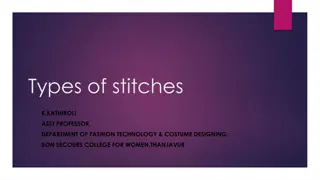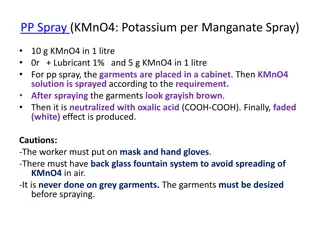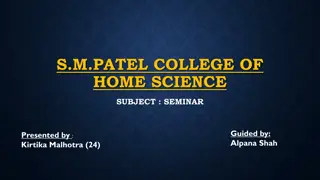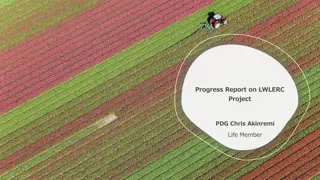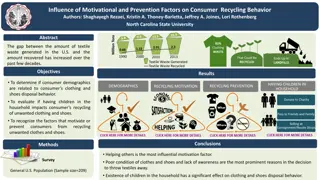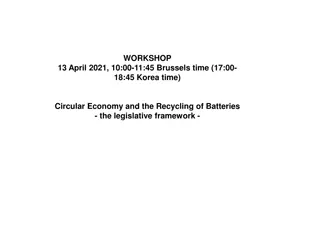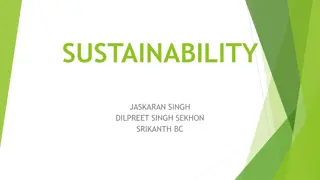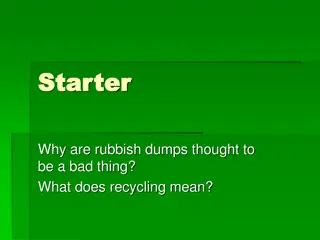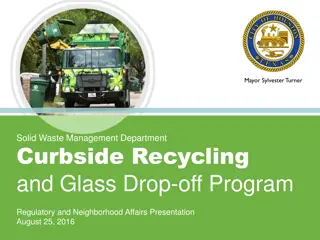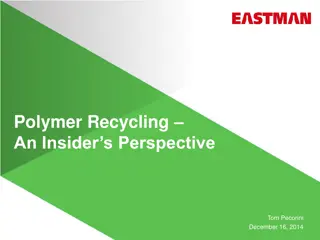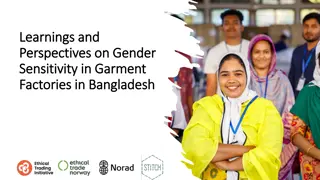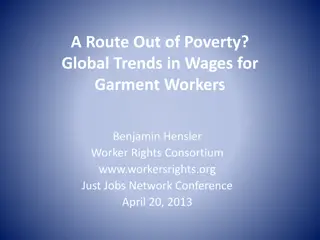Seminar on Garment Recycling Awareness and Techniques
Textile recycling involves reusing or reprocessing used clothing and fibrous materials to reduce waste. The seminar aimed to study garment recycling awareness among housewives from various socio-economic backgrounds. The methodology included data collection through surveys and interviews, with a focus on developing techniques for garment recycling to create value-added products.
Download Presentation

Please find below an Image/Link to download the presentation.
The content on the website is provided AS IS for your information and personal use only. It may not be sold, licensed, or shared on other websites without obtaining consent from the author. Download presentation by click this link. If you encounter any issues during the download, it is possible that the publisher has removed the file from their server.
E N D
Presentation Transcript
S.M.PATEL COLLAGE OF HOME SCIENCE SUBJECT: SEMINAR GUIDED BY : MS. ALPANA SHAH PRESENTED BY: MANISHA PARMAR 26
INTRODUCTION Textile recycling is the method of reusing or reprocessing used clothing, fibrous material and clothing scraps from the manufacturing process. The recycled garment are classified in three R s: 1. Repairing 2. Remodeling 3. Remarking Textile in municipal solid waste are found mainly in discarded clothing, although other sources include garments, footwear, accessories, decoration, etc.
AIM AIM A STUDY ON THE AWARENESS OF GARMENT RECYCLING & VARIOUS TECHNIQUES ADOPTED BY HOUSE WIVES OF VARIOUS SOCIO ECONOMIC STRATA
OBJECTIVE To study the awareness of garment recycling. To collect information or recycling techniques adopted by house wives. To inculcate awareness for and use of recycling technique. To develop socio economic up gradation through recycling technique.
METHODOLOGY Identification and selection of areas with different socio economy strata through random sampling method. Collection of data to survey technique by questionnaire cum interview method. Analysis of the selected data. Suggesting and teaching technique for garment recycling to make them as value added products.
REVIEW OF LITRATURE 1> Kaizen for reducing waste in weving unit. Kaizen philosopy can be applied in any textile weaving unit, which holds ample scope for saving money and time, demonstrates Arif k. naikwade.
2> Non woven composites from reclaimed fibers. Recycling is not always the preferred aproch, considering environmental impact and product competitiveness but may still outshine the alternatives and one example is the composite material made of reclaimed fibers, which today are widely used in automotive textiles disclose S.Sakthivel, S.Kathiresan, M.Vasanthi and K.Suganya.
3> Waste is so last season: Recycling clothes in the fashion industry. Experts on textiles and fashion took questions on creating a more sustainable fashion industry. Mechanical recycling chemical recycling The key differentiation is between mechanical fibre recycling , which will degrade with each recycling(down-cycling) and chemical fibre recycling which in some cases can produce fibresof equal quality to vergin once .
RESULT In selection of recycling & various techniques adopted by house wives of various socio- economic strata.
1> 20% of house wives are knowing Hand Stitching. 60% of house wives are knowing Machine Stitching. 20% of house wives are not knowing Stitching. 20% 20% Hand Stitch Machine Stitch Not knowing stitching 60%
2> 10% of house wives can stitch Womens wear. 10% of house wives can stitch Children's wear. 30% of house wives can stitch Home textiles. 50% of house wives can stitch others. 10% 10% Women's wear Children's wear Home Textiles others 50% 30%
3> 30% of house wives wear Trouser. 60% of house wives wear Kurta. 20% of house wives wear Saree. 0% of house wives wear shirt. 0% 10% 30% Trouser Kurta Saree Shirt 60%
4> 50% of house wives are wear their garment Till fashion last. 50% of house wives are wear their garment Warns out. Till fashion last Warns out 50% 50%
5> 70% of house wives are intrested in lerning for garment recycling. 30% of house wives are not intrested in lerning for garment recycling. intrested not intrested 30% 70%
6> 20% of house wives can make blankets from old garments. 50% of house wives can make door mates from old garment. 10% of house wives can make cushion cover from old garment. 20% of house wives can make everything. 20% 20% Blanckets Door Mates Cushion Cover Everithing 10% 50%
7> 60% of house wives are wants to sell the recycle garments. 40% of house wives are not want to sell the Recycle garment. 40 60
FINAL SUGGESTION The most of the housewives wants to develop learning skill for garment recycling. The housewives can produce new design of garments, household articles and accessories from learning the recycling of old /used garments or from waste of textiles. They can increase their family income from selling the recycled goods.
REFERENCES 1> The author is with the department of textile technology D K T E Textile and engineering institute ichalkaranji, Maharashtra. Email: arif.naikwade@yahoo.in. 2> 1)The text book of recycling in textiles edited by youjiang wang, published by woodhead publishing limited. 2) The text book of composites forming technology , edited by woodhead publishing limited.
3) US environmental protection agency (2005), Municipal solid waste generation, recycling, and disposal in the united states: facts and figures for 2003 , EPA530-F-05-003,12, April. 4) Engelhardt A (2005): fibre production hits all time high, international fibre journal, 6-8, April. 5) Prodromou A G and chen j: on the relationship between shear angle and wrinkling of textile composite preforms, composites part A.
6) Mohammad U, Lekakou C, Dong L and bader M G: Shear deformation and micromechanics of woven fabrics, composites part. 7) Potter K D: the influence of acuurate stretch data for reinforcements on the production of complex structural mouldings, composites. 8) Boisse P, Borr M, Buet K and cher-composite forming including the biaxial fabric behaviour, composites part B.
3) http://www.thegurdian.com/sustainable- buliness/sustainable-fashion- blog/2015/feb/26/waste-recycling-textiles-fashion- industry.





